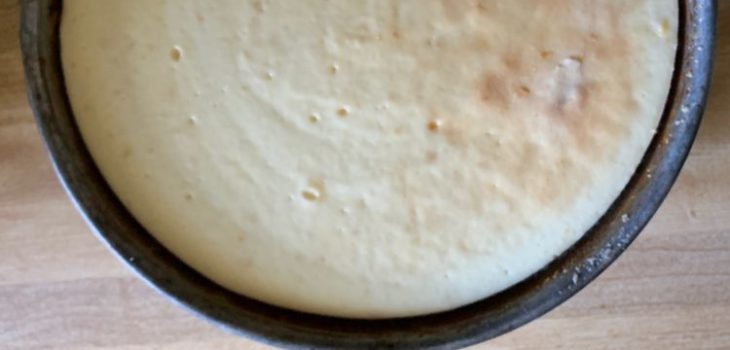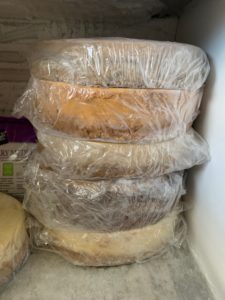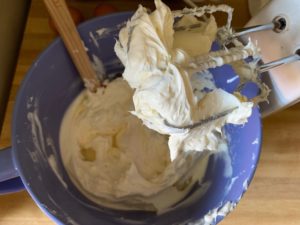
Tips for the perfect cheesecake: Baking binge leads to…
Mmm, cheesecake. Rich, creamy, delicious, perfect cheesecake. I’m almost becoming an expert at making these decadent desserts.
In the past month, I’ve made six of them, all different kinds. They may not be the perfect cheesecake, but I’ve come up with my own tips if you want to attempt your own piece of perfection.
Cheesecake instead of wedding cake
When my daughter and her fiancé decided to get married, they also decided they wanted cheesecakes instead of traditional wedding cake. I made two cheesecakes for their engagement party, and that was that.
We always said cheesecakes for a wedding would be terrific. Lots of different flavors. And really, nearly everyone loves cheesecake. It’s not traditional, though.
However, not much about this wedding is traditional, and that’s perfect. Every couple should create the celebration they want – not what everyone expects.
So, I’ve been making cheesecakes.
The bride and groom chose the flavors: plain with fruit topping (strawberry and blueberry), German chocolate, maple pumpkin with maple praline sauce, salted caramel with caramel sauce, peanut butter puppy chow and a fresh fruit-topped cheesecake, which I decided to make lemon instead of plain. Right now, they are stacked up in the freezer, waiting for the big day to be thawed, topped, displayed, sliced and eaten.
My daughter and her fiancé joked about getting married early, just so they could eat the cheesecake.
Magic of cheesecake revealed
I’ve been making cheesecakes for years. I’m not sure when I made my first one. It might have been for a Thanksgiving dessert when I was just out of college. I recall my favorite recipe for chocolate chip cookie dough cheesecake – with drops of cookie dough batter dolloped throughout. It had pecans in it, and a layer of mini chocolate chips.
I was a little daunted at first. Cheesecake seemed somehow magical, what with the springform pan and the quest to have a perfect top with no cracks. They seemed putzy, with lots of steps. Each one takes several hours from start to finish.
During the years, I tried many different recipes, actually collecting many of them into a folder my daughter still has in her kitchen cupboard. Through trial and error and lots of recipes, I figured out, finally, the way to make the perfect cheesecake. This recent baking binge has solidified what works for me to make the perfect cheesecake.
Oh, and I didn’t really follow any one recipe completely. I changed the ingredients, added or deleted toppings, adjusted the fillings and mixed different cakes with different crusts to get what I wanted. (You can use my tips with any recipe or make up your own!)
Making the perfect cheesecake?
Go online and you’ll find lots of recipes claiming to be the perfect cheesecake. Of course, the flavors will run across the board. So will the directions. It seems everyone with a food blog has made a cheesecake – with varying success. Rarely will they ‘fess up that they messed it up, despite the photographic evidence. I’d rather have someone be up front about their mistakes, so I don’t make them.
What got me in my latest research was a woman who has a food blog who claimed to have made the perfect cheesecake her first time out. Then, she went on to say that you didn’t need to do a water bath, and really, you just had to follow her steps exactly.
Um, no. I disagree.
You do need a water bath if you want to be absolutely sure it doesn’t crack. And no, you don’t need to follow her steps exactly. In fact, I found many different ways of doing and making cheesecake, and most worked just fine to get the same end result. My guess is she did some research and got really lucky with her first one. It happens.
That said, in doing six cheesecakes in such a short time, I also figured out what worked really well. I was able to replicate it over and over.
And you know what? Making the actual cheesecake is easy and not very time consuming. The baking/cooling process takes a long time, and it’s still putzy because of the multiple steps involved.
Don’t expect you can make a cheesecake for dinner when it’s 2 o’clock in the afternoon. You don’t throw this together like a pan of brownies. No, this is a planned dessert.
But, I believe anyone who can follow a recipe can make a cheesecake successfully.
No cheesecake for me
Here’s the sad part of all of this baking: I can’t eat it. Not that I don’t want to. Cheesecake was always one of my favorite desserts.
But when I made two cheesecakes for my daughter’s engagement party (traditional with cream topping and berry sauces and Reese’s Peanut Butter Cup chocolate peanut butter cheesecake), I tried a tiny, thin slice of each. Between the two of them, it didn’t even make one piece. They were so good and so rich. And I paid for that indulgence with a 36-hour headache.
I can’t do the sugar any more, even if I want to. Now, when I don’t follow my no-added sugar eating as well as I should, I can trigger a headache or even a migraine. It’s not worth it to me – the pain for such a small amount of pleasure.
Instead, I will make do with a tiny swipe from the inside of the springform pan when I remove it. There usually is a little cake and crust left behind, and I get the flavor of it without actually eating a whole bite. It would be tasty to try it, but I don’t want to be miserable for a day and a half.
Interestingly, I don’t crave cheesecake, desserts or sugar. I can make these and admire them. I can taste them and tell how good they will be, but I don’t crave a piece. Of course, I would like to eat it, because I know it would be enjoyable, but I don’t desire it like I would have at one time. That’s one of the upsides to eating cleaner, and it only takes 30 days to break the sugar habit and lose the cravings.
Pretty enough to eat

I still admire the cheesecakes, too. They are pretty, even without decoration. Each one that has come out of the oven reminds me of a full moon – different shades, slightly different bake patterns, but each one a rounded moon.
Stacked in the freezer, they layer like sedimentary rock, different colors separating the strata.
Once they are thawed and garnished, decorated and plated, they will be beautiful. Each one has a perfect surface – no cracks mar any of them. Not all came out as cleanly from the pans as I would have liked, but they are pretty nonetheless.
I guess I wouldn’t call them perfect, but they will do quite nicely.
Tips for the perfect cheesecake
If you want to make the perfect cheesecake, here are my suggestions. The more you follow, the better/easier it will be. Bakers, read on!
Prepare pan and crust
- Start with a springform pan. Nine-inch is standard. I use nonstick, because that’s what I’ve got in a 9-inch. I can use a knife on the inside and not scratch it.
- Butter the inside of the pan before you put in the crust or filling. Some recipes will suggest parchment paper, foil or cooking spray. I have butter (not margarine) on hand for the crust, so just use a little to wipe the inside and you’ll cut down on sticking. It’s easier than foil or parchment. I don’t use cooking spray, because I don’t like the residue or the flavor.
- You can make a crust out of anything that can be ground up: graham crackers, cookies (plain or with frosting in the middle), pretzels, nuts. You can follow your recipe or make up your own. My mom doesn’t like graham crackers, so I always substitute a different cookie when I’m baking for her. I’ve found lots of work arounds with my crusts, but if you’re starting out, follow your recipe amounts. Bake the crust as directed in your recipe.
Mix ingredients
- Bring your ingredients (cream cheese, eggs, even whipping cream or sour cream) to room temperature. Don’t microwave the cream cheese to soften it. Let it sit on the counter for an hour or so.

Cream cheese is mixed to make the perfect cheesecake. - Start with your cream cheese. Mix your cream cheese for 4 minutes on low speed. My mixer has six settings. I never go above a 2. Scrape your bowl often. Set a timer. You will think the time goes more quickly than it actually does. When it’s done, it will be nice and creamy.
- Add sugar. Mix another 3 minutes. It will be very creamy. Scrape your bowl.
- Add your eggs one at a time, and mix for 1 minute after each one. Scrape the bowl after at least every other egg.
- Follow your recipe directions for adding other ingredients.
- Pour the filling into the crust. It may reach the top or even go a little higher. This is OK. If it overflows, then stop, but most recipes will hit that level mark.
Prepare a water bath
You need the water bath, or you risk cracking your cheesecake. I’ve done it many times myself. This is foolproof.
- Get a big roasting pan. Buy a cheap aluminum one at a dollar store if you don’t own one. While you’re there, buy a two-pack of aluminum lasagna pans.
- Heat water on the stove to boiling. I let it boil, then turn it off and lid it until I’m ready to pour it in, but it could be boiling, too. It needs to be hotter than out of the tap.
- Take one of the lasagna pans and set your springform pan inside of it. Press in the edges around the springform pan, so the aluminum pan is close to it. It won’t be – and doesn’t have to be – a super tight fit. Don’t get any holes in the aluminum pan. You are creating a waterproof barrier for the water bath. You want to keep the water out of your cheesecake.
- Many recipes suggest big sheets of heavy duty aluminum foil for this. However, I’ve had that method leak, resulting in a soggy crust. Since I started using the cheap aluminum pans, it’s worked perfectly. I was able to use one pan for four cheesecakes, before some of the batter overflowed. I didn’t feel like cleaning it out, so I tossed the pan and started using a fresh one.
- Fold the edges in, curving the corners in toward the springform pan. I allow enough room to still lift the springform pan out easily. It’s best to do this the first time when your pan is empty or only has the crust. Once it’s full of the batter, it could get messy.
- Open the preheated oven, pull out the rack, set the big roasting pan on it. Gently set the batter-filled springform pan wrapped in aluminum into the roasting pan. Fill the roasting pan with enough hot water to come at least halfway up the aluminum surrounding the springform. Slide the rack back in gently.
Bake the cake
- Close the oven door.
- Set a timer.
- I bake my cheesecakes at 325 degrees for 1 hour and 15 minutes. You’ll find lots of times and temps, but this is what I’ve worked out to be the best.
- When the timer goes off, turn off the oven and set another timer for 30 minutes. Do not open the oven door. You don’t need to check the cheesecake. Don’t worry about jiggly centers or set edges. If you open the door, you’ll lose heat, which you need to finish baking the cheesecake, even as it starts to cool.
- When the timer goes off after 30 minutes, crack the oven door. Set another timer for 30 minutes. Again, you don’t need to shake it or touch it. It’s cooling, and you want it to cool slowly or it may crack.
- When the timer goes off again, you can open the oven door and remove the foil wrapped springform pan. By this time, the roasting pan and aluminum wrapping should be cool to the touch. The springform pan may still be hot on the bottom. Take it out of the aluminum wrapping and set it on the top of the stove or a cooling rack for another 15 minutes. Discard the water from the roasting pan. (If you plan to reuse it, hold it up the light to check to make sure it doesn’t have a hole before you use it next time.)
Store the cake
- Use aluminum foil to cover the cheesecake. I try to tent it over the springform pan so it doesn’t touch the cheesecake. The surface is still fragile at this point, so don’t touch it. I use two pieces, one going one way, and the other the opposite. Place it in the refrigerator for at least 4 hours or overnight.
Remove cheesecake from the pan
- Remove the aluminum foil.
- Use a long-bladed, thin, sharp knife to slide around the edge of the pan, reaching all the way to the bottom. You’re cutting the cake away from the springform, since it likely will stick despite whatever you put on to release it. Once in a while, I’ll get a batter that pulls away nicely, but I don’t count on it.
- Place the springform pan on a small plate. I flip a dessert plate upside down, so it doesn’t slide. You want the springform raised up slightly, so when it releases, you have a little give both up and down with it.
- Gently release the springform latch, holding the form in both hands and trying to keep it steady as it pulls away from the cake. Lift it off the cake straight up. You may need to drop it down just a touch to release all of the crust at the bottom.
- If any crust comes up the sides or onto the top, brush it off gently.
- If you plan to serve the cake, you can top it, decorate it or garnish it as you wish or as your recipe suggests. Use a sharp thin knife to slice it into pieces. If you dip the blade into hot water before each slice, it helps keep the cake from sticking, and the pieces look nicer.
Freeze cheesecake
- If you plan to freeze the cheesecake until later, use plastic wrap – two pieces, one each direction – to wrap the cheesecake. Leave it on the springform base, and place it on a hard, flat surface in your freezer, such as the bottom of the freezer or a sturdy cake pan or cookie sheet. Allow the cake to freeze completely – overnight is fine.
- Once the cake is frozen, remove it from the freezer and turn it upside down on your countertop, still wrapped in plastic. Use a thin, long knife to slide between the springform base and the crust, turning and sliding around the cake. Most crusts will release easily, but you don’t want to lose any. Sometimes, they stick, so use the knife evenly around the base to ensure all of the crust stays intact. Some crusts, such as those containing caramel, may really stick and require more work to release them.
- Once free from the form, re-wrap in plastic wrap and place in the freezer.
- If you plan to freeze a cheesecake for more than a month, wrap it in aluminum foil, too.
- When you plan to serve it, unwrap the frozen cheesecake and place it on a serving plate. Cover the plate and cake with plastic wrap and place it in the refrigerator overnight or until it’s thawed to your liking. Decorate or garnish as you wish before serving.
How to Be a Better Writer Tip
Give your audience what they want
This is not a recipe for the perfect cheesecake. Nope, it’s tips for making a perfect cheesecake — or as near perfect as you can get without actually using magic. And it’s about my quest for that perfection.
That said, I did include lots of step-by-step instructions, because I thought it might help people who would like to successfully make a cheesecake.
Writing all of those tips made this post really long — more than 2,700 words. So I grouped those tips at the end of the post.
This is counter-intuitive to prevailing wisdom. If this actually was a recipe post or a straight up blog about baking tips, it would make more sense to put those tips at the start of the article. Don’t make readers look for information. Give it to them in a way that’s easy to read, understand and follow. Give your audience what they want.
But this is not a recipe post or even a tip blog. This is a personal blog, and I happen to be sharing what I’ve learned in practice about making a perfect cheesecake.
In this case, I kept my personal information first for readers who probably didn’t click on this article for baking tips.
Think about your audience as you write. Are you giving them the information they want when they want it? That’s a topic we will
come back to later.




4 COMMENTS
Great article. LOVE your cheesecakes!!! Thanks for the baker tips! Must admit, I’m intimidated to make cheesecake. It truly is a “labor of love”. The bride and groom chose great flavors – sounds wonderful. Happy to hear that the bride has your recipes for reference. 🙂
You really must make one, Jane. Pick your favorite flavor, find a recipe and set aside an afternoon! You’re good at making so many other things, this would be “a piece of cake” for you. 🙂
P.S. And very sorry to hear that you cannot savor the flavor yourself.
Ha ha! Yes, that is the drawback. But it’s OK. It’s kind of like being super full at Thanksgiving and thinking dessert would taste good, but you certainly aren’t hungry for it, and you don’t really want to eat it. That’s where I’m at with sugar these days. It looks good, smells good and even a taste is good (often too sweet), but I don’t want it.